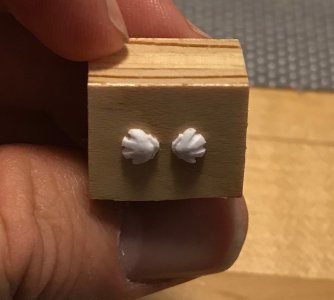Hi Marc, maybe I missed something,,, how did you make the original moulds?
-

Win a Free Custom Engraved Brass Coin!!!
As a way to introduce our brass coins to the community, we will raffle off a free coin during the month of August. Follow link ABOVE for instructions for entering.
You are using an out of date browser. It may not display this or other websites correctly.
You should upgrade or use an alternative browser.
You should upgrade or use an alternative browser.
Soleil Royal by Heller - an Extensive Modification and Partial Scratch-Build by Hubac’s Historian
- Thread starter Hubac’s Historian
- Start date
- Watchers 80
-
- Tags
- 1689 heller hubac refit soleil royal
I’ve been plugging away on this f’ocsle breast rail and belfry, here and there, when I can.
I made enough BONDO scroll ornaments so that I didn’t have any difficulty selecting for the best and most consistent examples:
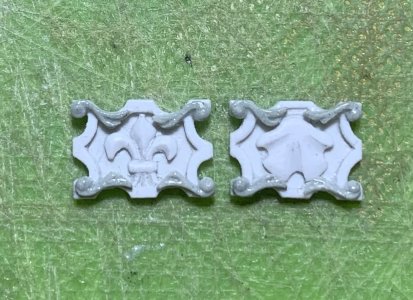
I coat them with a little thin CA, once they’re in place, just as a precaution - in case there were any micro fissures or fractures.
The belfry came together sequentially.
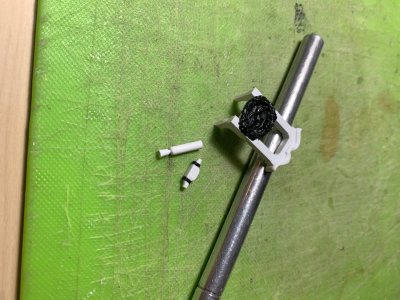
Turning the bell took a few attempts. I overheated the plastic, on the first try, and the bell winged-out on me.
I made the cap rail from a couple of layers to give me a thickness of 3/64ths.


It was necessary to fit a center section of caprail to the belfry assembly. The side sections will be mortised for the timberheads, and joined to the center section later.
All-in-all, I’m really pleased with how it’s coming along:

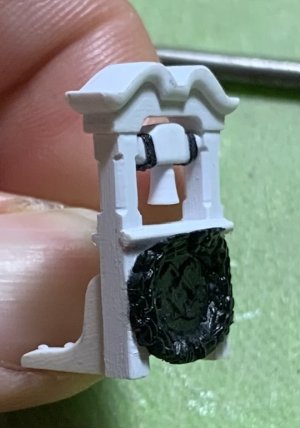

As always, thank you for taking time out to look-in at this build.
More to come…
I made enough BONDO scroll ornaments so that I didn’t have any difficulty selecting for the best and most consistent examples:

I coat them with a little thin CA, once they’re in place, just as a precaution - in case there were any micro fissures or fractures.
The belfry came together sequentially.

Turning the bell took a few attempts. I overheated the plastic, on the first try, and the bell winged-out on me.
I made the cap rail from a couple of layers to give me a thickness of 3/64ths.


It was necessary to fit a center section of caprail to the belfry assembly. The side sections will be mortised for the timberheads, and joined to the center section later.
All-in-all, I’m really pleased with how it’s coming along:



As always, thank you for taking time out to look-in at this build.
More to come…
The level of detail you manage at this scale is mind-numbing, Marc. So impressive in every way. I would love to see this ship model in person one day...
If you are ever in New York, you are welcome anytime, Paul. Thank you!
Excellent work Marc, I am very much looking forward to the big reveal when all the parts come together
I have decided to keep my momentum going, and I am currently in the process of designing and making my QD breast rail.
In a moment of pre-install vanity, here is the f’ocsle belfry placed:
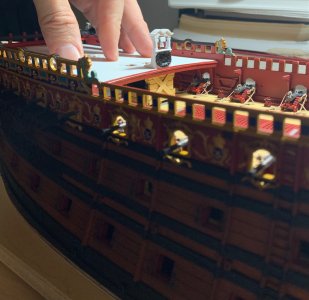
I wanted to be sure that the scale of the thing looked right, although I did mock-up the main stay during the design process and the top of the belfry is well below it. With the Louis Quinz model as my reference, I think it looks just about right:


photos courtesy of Marc Yeu
Continuing the theme of bringing the outboard details, inboard, I used the main deck level balcony rail as my design reference:
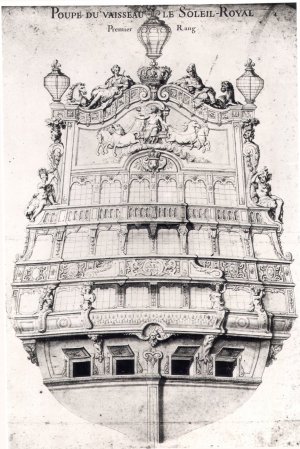
The wonderful part of this hobby is that you are constantly learning and refining technique:

In order to more uniformly draw the three port side lattice frames, I realized I could create a series of reference lines (diagonals and a mid-line) that would help me to layout these shapes in a consistent way.
I was lucky that I still had six oval cartouches that I could extract from the kit QGs. It was necessary, though, for me to cast another name cartouche out of BONDO, which came out with perfect casted detail.
The oval cartouches are cast with tiny fleur-de-lis. On each side of the central panel, I will engrave the central ovals with the crossed-Ls monogram of Louis XIV, while the outer ovals will remain fleurs.
Little by little, we are getting there! Thank you for visiting the build!
Bonus - I found this amazing VdV portrait of an unknown Dutch two-decker. I just love the beautiful silhouette these Dutch ships cut on the water:

In a moment of pre-install vanity, here is the f’ocsle belfry placed:

I wanted to be sure that the scale of the thing looked right, although I did mock-up the main stay during the design process and the top of the belfry is well below it. With the Louis Quinz model as my reference, I think it looks just about right:


photos courtesy of Marc Yeu
Continuing the theme of bringing the outboard details, inboard, I used the main deck level balcony rail as my design reference:

The wonderful part of this hobby is that you are constantly learning and refining technique:

In order to more uniformly draw the three port side lattice frames, I realized I could create a series of reference lines (diagonals and a mid-line) that would help me to layout these shapes in a consistent way.
I was lucky that I still had six oval cartouches that I could extract from the kit QGs. It was necessary, though, for me to cast another name cartouche out of BONDO, which came out with perfect casted detail.
The oval cartouches are cast with tiny fleur-de-lis. On each side of the central panel, I will engrave the central ovals with the crossed-Ls monogram of Louis XIV, while the outer ovals will remain fleurs.
Little by little, we are getting there! Thank you for visiting the build!
Bonus - I found this amazing VdV portrait of an unknown Dutch two-decker. I just love the beautiful silhouette these Dutch ships cut on the water:

That's several posts now this fall. Can he sustain the breakneck pace??? 

Probably not, but I am going to try 
- Joined
- Jan 21, 2022
- Messages
- 837
- Points
- 403

If you need more of those I can make you a stl for 3d printI was lucky that I still had six oval cartouches that I could extract from the kit QGs. It was necessary, though, for me to cast another name cartouche out of BONDO, which came out with perfect casted detail.
Thank you, WojtasS, but I should be okay from here on out. The poop deck breast rail will be the Arms of France, and that will complete the ornamental program. I appreciate the offer, though.
- Joined
- Jan 21, 2022
- Messages
- 837
- Points
- 403

If you need some specific ornament for SR just send me a messageThank you, WojtasS, but I should be okay from here on out. The poop deck breast rail will be the Arms of France, and that will complete the ornamental program. I appreciate the offer, though.
Thank you very much, Chris!

Just for your information. I had never heard of the model before.
Schmidt
There was an Artikel in Das Logbuch several years ago...
Just for your information. I had never heard of the model before.
Schmidt
Fascinating - thank you! I have never seen this model before.
A number of you have reached out and said a lot of really complimentary things about the work on these railings, and the model in general. That is very meaningful to me, and I really appreciate it!
I do want to take a minute, though, and talk a little bit about process, as there may be people watching along through all of this and thinking “well, I could never do anything quite like THAT.”
My resounding reply to anyone who may be feeling that way is that you absolutely can achieve these things.
While it is true that I have developed fine motor skills over the course of my lifetime, and they are essential, I think what is often considered “talent” largely boils down to one’s powers of observation.
Here is what I mean. Whether it be 17th Century French warships, or 18th Century American longrifles, or Art Nouveau furniture - to name my three most passionate period interests - I think it is essential to constantly be on the search for previously unknown and increasingly better examples of these things, so that you can better appreciate what constitutes Good, Better and Best (Israel Sack’s guide to period furniture) examples of any given type. This is why I love scrolling through Pinterest so much. Every so often, the algorithm sends me a gift of something I had never seen before!
More than any other skill that I posses, I believe it is my ability to really home-in on, and scrutinize the details of a thing, that has enabled me to recreate them with reasonable verisimilitude to their times. I really pore over drawings and photographs for excessively long periods of time, and often revisit them until I understand the details well enough to actually draw them.
This has always been my litmus test; when I can finally clearly visualize something in my mind’s eye well enough to draw it in a clear and detailed way - then, I absolutely know that I can make that thing.
Perfection is never my goal. All aspects of this model, or anything I have made, are slightly irregular. What I am trying to achieve, though, is the uniform application of my powers of observation, in concert with my dexterities to the object in-hand. In other words: I am committed to maintaining a certain standard of execution. The more contemporary models you look at, the more you will come to realize that they all have in-common these slight irregularities of shape and proportion.
This is why the project has carried on for as long as it has. Soleil Royal is a magnificently complicated vessel, and I have endeavored to include as much of that detail as I reasonably can.
The QD breast rail is emblematic of this process. When you really study it, you can find all manner of a-symmetries:
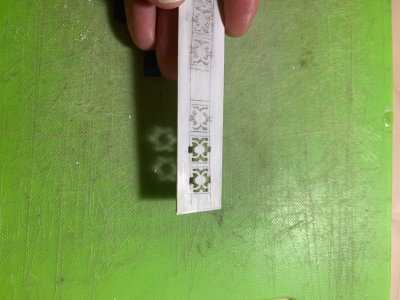

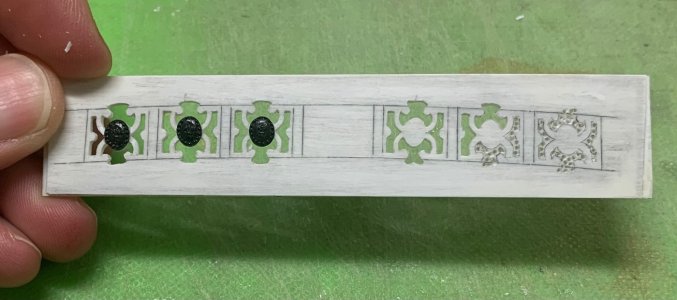
However, as with painting, it is my habit to work an individual panel, for example; get it fretted pretty close to where I want it to end up; regularly flip the work from front to back to make sure I’m not cutting out of square; and, finally, to come back and re-work each panel so that they are as consistent as I can make them.
The secret to all of this is just time. I enjoy the process, so the enormous amounts of time I spend whittling away don’t really matter too much.
In closing, all of these things you see me doing were learned right here in the process of making THIS very model. My skills have improved tremendously over that span of time.
These things are achievable. You can do them too, and the process of learning to opens doors to what you are capable of within the hobby. You are suddenly no longer constrained by whatever kit manufacturers deem profitable enough for manufacture.
Thank you for indulging my reverie.
All the best,
Marc
I do want to take a minute, though, and talk a little bit about process, as there may be people watching along through all of this and thinking “well, I could never do anything quite like THAT.”
My resounding reply to anyone who may be feeling that way is that you absolutely can achieve these things.
While it is true that I have developed fine motor skills over the course of my lifetime, and they are essential, I think what is often considered “talent” largely boils down to one’s powers of observation.
Here is what I mean. Whether it be 17th Century French warships, or 18th Century American longrifles, or Art Nouveau furniture - to name my three most passionate period interests - I think it is essential to constantly be on the search for previously unknown and increasingly better examples of these things, so that you can better appreciate what constitutes Good, Better and Best (Israel Sack’s guide to period furniture) examples of any given type. This is why I love scrolling through Pinterest so much. Every so often, the algorithm sends me a gift of something I had never seen before!
More than any other skill that I posses, I believe it is my ability to really home-in on, and scrutinize the details of a thing, that has enabled me to recreate them with reasonable verisimilitude to their times. I really pore over drawings and photographs for excessively long periods of time, and often revisit them until I understand the details well enough to actually draw them.
This has always been my litmus test; when I can finally clearly visualize something in my mind’s eye well enough to draw it in a clear and detailed way - then, I absolutely know that I can make that thing.
Perfection is never my goal. All aspects of this model, or anything I have made, are slightly irregular. What I am trying to achieve, though, is the uniform application of my powers of observation, in concert with my dexterities to the object in-hand. In other words: I am committed to maintaining a certain standard of execution. The more contemporary models you look at, the more you will come to realize that they all have in-common these slight irregularities of shape and proportion.
This is why the project has carried on for as long as it has. Soleil Royal is a magnificently complicated vessel, and I have endeavored to include as much of that detail as I reasonably can.
The QD breast rail is emblematic of this process. When you really study it, you can find all manner of a-symmetries:



However, as with painting, it is my habit to work an individual panel, for example; get it fretted pretty close to where I want it to end up; regularly flip the work from front to back to make sure I’m not cutting out of square; and, finally, to come back and re-work each panel so that they are as consistent as I can make them.
The secret to all of this is just time. I enjoy the process, so the enormous amounts of time I spend whittling away don’t really matter too much.
In closing, all of these things you see me doing were learned right here in the process of making THIS very model. My skills have improved tremendously over that span of time.
These things are achievable. You can do them too, and the process of learning to opens doors to what you are capable of within the hobby. You are suddenly no longer constrained by whatever kit manufacturers deem profitable enough for manufacture.
Thank you for indulging my reverie.
All the best,
Marc
Last edited:
A very fine treatise, Mark. Thanks for taking the time to share these thoughts with us!



